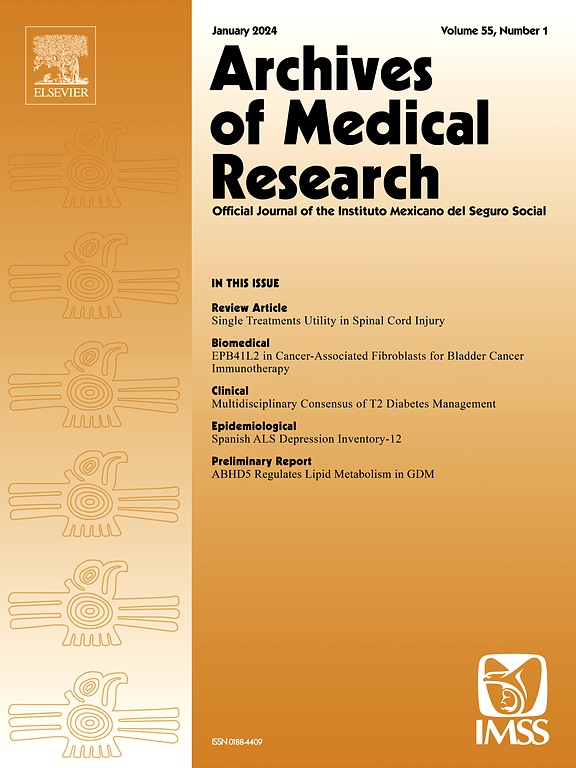线粒体代谢物甲基丙二酸、亚临床心肌损伤及其对心血管死亡风险的增量预测价值
IF 3.4
3区 医学
Q1 MEDICINE, RESEARCH & EXPERIMENTAL
引用次数: 0
摘要
背景和目的甲基丙二酸(MMA)参与心肌线粒体损伤和能量代谢紊乱。我们试图研究MMA与亚临床心肌损伤的关系,以及它在基于常规危险因素和心脏生物标志物预测心血管死亡风险方面的增加价值。方法本研究纳入11,373名年龄≥18岁、无常见心血管疾病(CVD)的参与者。我们评估了MMA与心脏生物标志物(高敏感性心肌肌钙蛋白[hs-cTn]和n端前b型利钠肽[NT-proBNP])亚临床升高的横断面相关性,以及它们与长期死亡率的前瞻性关联。估计10年心血管死亡率的预测性能。结果MMA与心脏生物标志物升高之间存在显著的剂量-反应关系。与MMA最低四分位数的参与者相比,hs-cTnT和NT-proBNP升高的最高四分位数的多变量调整比率(95% ci)分别为2.35(1.64-3.37)和1.35(1.12-1.62)(每个p趋势<;0.001)。引人注目的是,在MMA水平升高的成年人中,与hs - cTnT或NT - proBNP升高相关的心血管死亡风险至少是MMA水平较低的成年人的两倍。在MMA≤125 nmol/L的人群中,hs - cTnT升高对心血管死亡率的校正风险比(95% ci)为1.58(1.00-2.50),而在MMA≤125 nmol/L的人群中,hs - cTnT升高对心血管死亡率的校正风险比为2.45(1.94-3.11)。结论mma积累与心血管事件发生前亚临床心肌损伤独立相关。这些发现支持线粒体相关指标的附加价值,以指导基于心脏生物标志物的心血管事件高危人群筛查。本文章由计算机程序翻译,如有差异,请以英文原文为准。
Mitochondrial Metabolite Methylmalonic Acid, Subclinical Myocardial Injury, and its Incremental Predictive Value for Cardiovascular Mortality Risk
Background and Aims
Methylmalonic acid (MMA) is involved in myocardial mitochondrial damage and energy metabolism disorders. We sought to investigate the association of MMA with subclinical myocardial injury and its incremental value in predicting cardiovascular mortality risk based on conventional risk factors and cardiac biomarkers.
Methods
This study included 11,373 participants aged ≥18 years without prevalent cardiovascular disease (CVD). The cross-sectional associations of MMA with subclinical elevation of cardiac biomarkers (high-sensitivity cardiac troponin [hs-cTn] and N-terminal pro-B-type natriuretic peptide [NT-proBNP]), and their prospective associations with long-term mortality, were assessed. The predictive performance for 10-year cardiovascular mortality was estimated.
Results
The association between MMA and elevated cardiac biomarkers was significant with a dose-response pattern. Compared with participants in the lowest quartile of MMA, the multivariable-adjusted rate ratios (95% CIs) in the highest quartile for elevated hs-cTnT and NT-proBNP were 2.35 (1.64–3.37) and 1.35 (1.12–1.62), respectively (each p trend <0.001). Strikingly, the cardiovascular mortality risk associated with elevated hs‐cTnT or NT‐proBNP was at least two-fold higher in adults with elevated MMA levels than in those with lower MMA levels. The adjusted hazard ratios (95% CIs) of elevated hs‐cTnT for cardiovascular mortality were 1.58 (1.00–2.50) among individuals with MMA ≤125 nmol/L and 2.45 (1.94–3.11) among participants with MMA >125 nmol/L.
Conclusion
MMA accumulation is independently associated with subclinical myocardial injury before cardiovascular events occur. These findings support the additional value of mitochondria-related indicators to guide cardiac biomarker-based screening of populations at high risk for cardiovascular events.
求助全文
通过发布文献求助,成功后即可免费获取论文全文。
去求助
来源期刊

Archives of Medical Research
医学-医学:研究与实验
CiteScore
12.50
自引率
0.00%
发文量
84
审稿时长
28 days
期刊介绍:
Archives of Medical Research serves as a platform for publishing original peer-reviewed medical research, aiming to bridge gaps created by medical specialization. The journal covers three main categories - biomedical, clinical, and epidemiological contributions, along with review articles and preliminary communications. With an international scope, it presents the study of diseases from diverse perspectives, offering the medical community original investigations ranging from molecular biology to clinical epidemiology in a single publication.
 求助内容:
求助内容: 应助结果提醒方式:
应助结果提醒方式:


